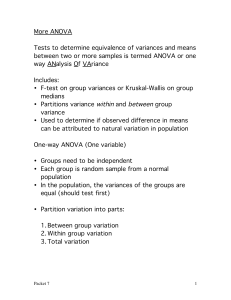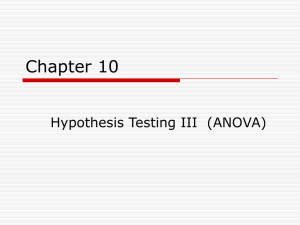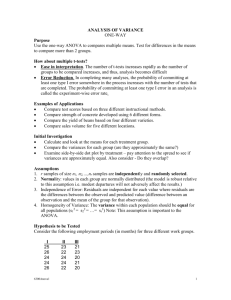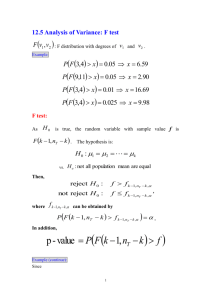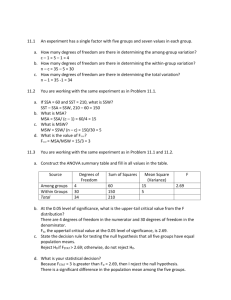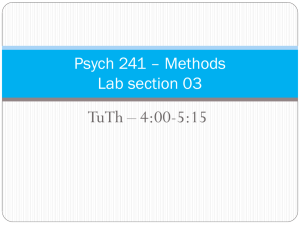CHAPTER_10_ANOVA_-_One_way_ANOVA
advertisement
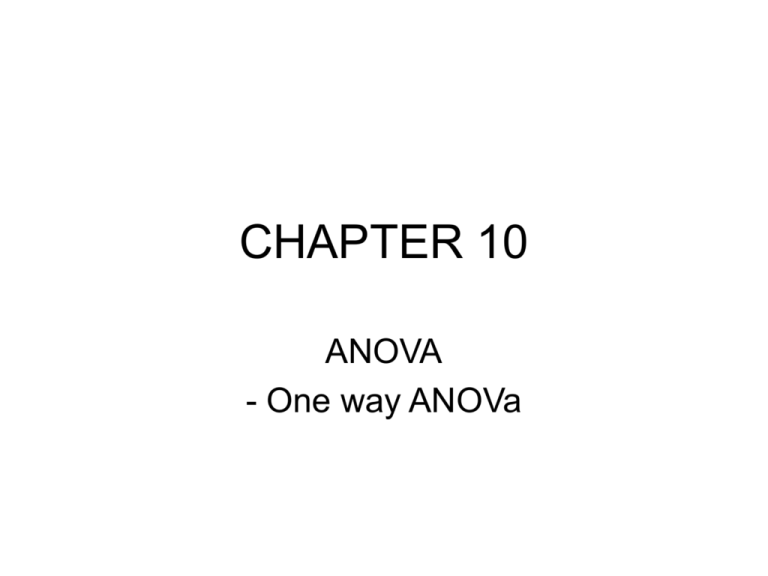
CHAPTER 10 ANOVA - One way ANOVa One-way ANOVA • - test the hypothesis that the means of three or more populations are the same. • The alternative hypothesis is that not all population means are the same. • Example: Students taught by 3 different methods (Methods I, Methods II and Methods III) aimed at improving their Mathematics scores • The null hypothesis is: All three population means are the equal Ho: µ1 = µ2 = µ3 • The alternative hypothesis: Not all three population means are equal H1: Not all three means are equal Assumptions of One-way ANOVA • 1) the populations from which the samples are drawn are (approximately) normally distributed. • 2) The populations from which the samples are drawn have the same variance (or standard deviation) • 3) The samples drawn from different populations are random and independent • The ANOVA test is done by calculating 2 estimates of the variance, α2, of the population distributions: 1) the variance between samples also called Mean Square between samples or MSB 2) the variance within samples also called Mean Square within samples, or MSW The value of the F statistic for ANOVA is given by: VarianceBe tweenSamples MSB F VarianceWi thinSamples MSW Symbols used • x = score of students • k = the number of different samples (or treatments) • ni = the size of sample i • Ti = the sum of the values in sample i • n = the number of values in all samples = n1 + n2 + n3 + n4 + …. • Σx = the sum of the values in all samples = T1 + T2 + T3 + T4 + …. • Σx2 = the sum of the squares of the values in all samples • To calculate MSB and MSW, first calculate between samples sum of squares (SSB) and within-samples sum of squares (SSW) T1 T x T SSB ...... n n n n 2 3 1 2 2 2 2 3 2 2 2 2 T T T 2 3 1 2 SSW X ...... n1 n1 n3 SSB MSB k 1 SSW MSW nk Example of One-way ANOVA Calculation • Fifteen students were taught using 3 different methods I, II and III and the Mathematics scores obtained are as follows: Method 1 48 73 51 65 87 Method II 55 85 70 69 90 Method III 84 68 95 74 67 T1 = 324 T2 = 369 T3 = 388 n1 = 5 n2 = 5 n3 = 5 Σx = T1 + T2 + T3 = 324 + 369 + 388 = 1081 n = n1 + n2 + n3 = 5 + 5 + 5 = 15 Σx2 = square of all the scores in the 3 samples and add them = (48)2 + (73)2 + (51)2 + (65)2 + ….. = 80,709 3242 369 2 3882 10812 SSB 432.133 5 5 15 5 3242 369 2 3882 2372.8000 SSW 80,709 5 5 5 SST SSB SSW 432.1333 2372.8000 2804.9333 MSB MSW SSB 432.1333 216.0667 k 1 3 1 SSW 2372.8000 197.7333 nk 15 3 MSB 216.0667 F 1.09 MSW 197.7333 Degrees of freedom for the numerator of F = k – 1 = 3-1 = 2 Degrees of freedom for the denominator of F = n – k = 15 – 3 = 12 Look in the F distribution table: For the 2 df for numerator and 12 df for the denominator, the critical value F is 6.93 Do not reject Ho Reject Ho α = .01 6.93 Critical value of F DECISION: The F value calculated (1.09) is less than the critical value 6.93. It falls In the non-rejection region. So, do not reject Ho. There are no significant differences (p < .01) between the three groups. Which means that the treatment (teaching of mathematics using the 3 different methods) do not affect the mathematics Scores of students. How to produce the One-way ANOVA table for your research report (see my SPSS book p119) EDUC Sum of Squares Between Groups df Mean Square 432.133 2 216.067 Within Groups 2372.800 12 197.733 Total 2804.933 14 F Sig. 1.090 NS How to report the results of your One-way ANOVA table (See my SPSS book p 122) Exercise 1 A Science teacher wanted to test three different methods of teaching a difficult topic. She randomly selected 21 students and randomly divided them into three groups and taught the three groups in 3 different ways. The following are the marks obtained by the students: Method I Method II Method III 15 11 9 8 16 17 17 9 11 7 16 8 26 24 15 12 20 6 8 19 14 a) State the null and the alternative hypothesis b) Show the rejection and nonrejection regions on the F distribution curve for α = .025 c) Calculate SSB, SSW and SST d) What are the degrees of freedom for the numerator and the denominator e) Calculate the between-samples and within-samples variances f) What is the critical value of F for α = .025? g) What is the calculated value of the test statistic F? h) Write the ANOVA table for this exercise i) Will you reject the null hypothesis stated at α = .025?
